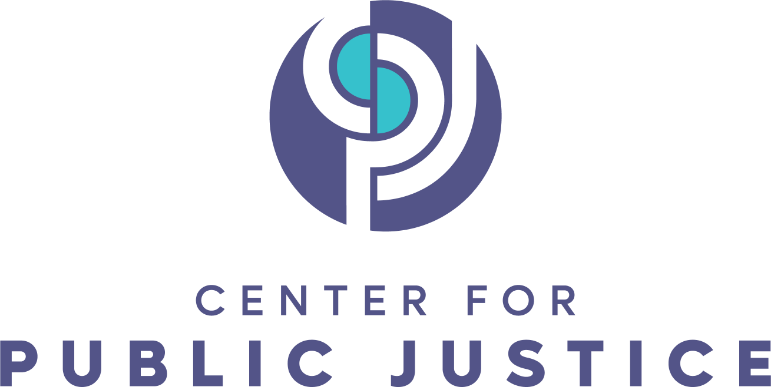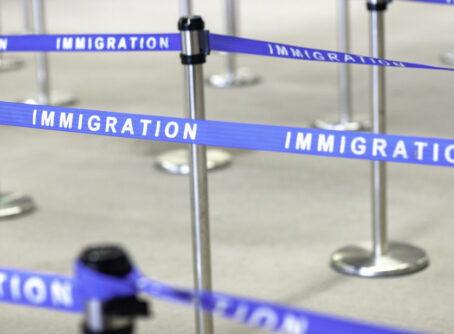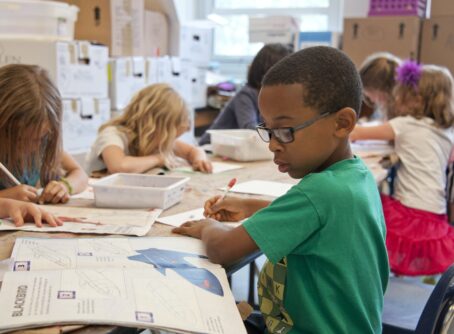
This article is a part of Shared Justice’s Series, Voices of Youth Diversion. This series looks at ways that community organizations, in partnership with state and local governments, are working together to rehabilitate youth and reduce the harmful impacts of youth interaction with the justice system.
Youth rearrest rates within one year of release average around 55 percent across the United States, with many youth involved in the justice system continuing into adulthood. Such a high rearrest rate indicates that we need to take a closer look at the factors preventing youth from successfully making and establishing the positive connections with people outside the system that they need in order to keep from reoffending. Although youth detention has declined steadily over the past few decades, there were 186,600 detained delinquency cases in 2019 (the most recent federal data), accounting for 26 percent of all youth delinquency cases. There are many problems plaguing the youth justice system, including faults in the probation system, high levels of recidivism and lack of access to resources for low-income and minority youth. However, one problem that is seldom discussed and has a significant impact on youth is the use of detention centers. The Juvenile Justice Advocates at Howard University are an excellent example of how advocacy can make a difference in the lives of detained youth.
Juvenile detention is defined as short-term confinement for youth while they await trial to determine innocence or guilt. Pre-trial detention occurs only when a court determines that it is likely a youth suspected of committing a crime might flee while awaiting trial. The average stay in detention is 27 days. Youth detained while awaiting trial are more likely to be formally charged, have more long term mental health issues and have a lower likelihood of graduating high school. The Annie E. Casey Foundation and the University of Washington Foundation found in 2020 that pretrial juvenile detention increases the likelihood of felony recidivism by 33 percent and misdemeanor recidivism by 11 percent, regardless of length of stay. Nevertheless, detention continues to be a common aspect of the juvenile justice system despite the known risks it imposes on young people at risk of crime.
“…flourishing for the youth involved in the justice system can happen when civil society organizations and government cooperate.
It is important to invest in and develop local diversion programs that reduce youth contact with the juvenile justice system. Diversion programs aim to redirect youth from the justice system through intervention and alternatives to traditional modes of punishment. According to a meta analysis of three types of diversion programs conducted by the National Institute of Corrections, youth diversion programs reduce the risk of recidivism by almost 10 percent, displaying the significant effect of diversion programs. On the other hand, it is also important to address the needs of youth who do go through the traditional juvenile justice system. As stated above, those who are held in detention centers or incarcerated as a youth have a much higher risk of remaining in the system, beginning a potentially lifelong cycle that affects communities for generations. For instance, 66 percent of youth who are incarcerated never go back to school, which greatly disadvantages them in the labor market. Diversion programs and detention-center programs intervene to break this cycle. Regardless of whether a young person is in danger of becoming part of the juvenile justice system or is already in it, they still need to hear the same message: that they are loved, there is hope, and they can change. Diversion and intervention programs strive to communicate this message of dignity and value to youth through support, care and education.
THE PUBLIC JUSTICE RESPONSE
The systemic issues that lead to youth criminalization call for a robust public justice response. According to the Center for Public Justice, public justice is a guiding framework for government and civil society organizations as they both work towards human flourishing by exercising their unique roles and responsibilities. In Shared Justice’s interview with Iliana Pujols, she outlined a basic idea for what flourishing looks like in the youth justice system. She said that addressing the root causes of youth criminalization (which reflect long-term issues in local communities) is essential to making real change in the lives of youth involved in the justice system so that their risk of recidivism decreases and their life opportunities increase. A public justice response in the case of addressing these root causes thus implicates both government and civil society to work alongside youth, providing them with tools for restoration and hope in their lives. As displayed through the Howard University Juvenile Justice Advocates program, flourishing for the youth involved in the justice system can happen when civil society organizations and government cooperate.
GIVING YOUTH HOPE: THE JUVENILE JUSTICE ADVOCATES
The Juvenile Justice Advocates (JJA) at Howard University work to encourage, mentor and inspire hope in youth going through the justice system. According to the president of the Juvenile Justice Advocates, senior Davina Scott, the group organizes a six week program for mentoring detained youth at DC’s Youth Services Center (YSC). Scott and sophomore Naquel Perry Jr. shared that before these Howard students even begin to engage with the detained youth scholars at YSC, they go through two training sessions hosted by JJA as well as an orientation hosted by supervisors at YSC. She said, “Our program plan [One Step Away] includes things such as emotional and physical regulation [for mentees], what to do when you’re in a situation where you just experienced something traumatic, how do you cope with that? Because some of them have never learned how to cope with that, we also want to expose them to different aspects of the world.”
This mentorship style is based around the understanding that, as freshman Isabella Miller said, “We’re all human. Just as we want to help the scholars, they’re going to be there to support us. All of us are here to support each other.” Howard JJA participants want youth at YSC to know that they are cared for, and that comes across in their intentionality to build relationships with the youth they mentor at YSC. These relationships provide the context for also taking on difficult conversations about trauma, painful experiences and plans for the future. This holistic, trauma-informed approach that JJA applies to mentorship has been shown to help build resilience in youth. People who have experienced traumatic events in their life can heal and grow so that they can envision/realize a hopeful trajectory for their futures. Their hope, junior Chandler Robinson explains, is to keep youth from continuing through the adult system. “We don’t often think about the youth system which leads right into the adult system, so I think it’s equally as important to start at the bottom. So that we can stop as many people from kind of staying in the system and continuing through the system.” As Ben Peterson and Maelene Rosales explain, these models also help create behavioral change in youth by capitalizing on the unique relationships created in mentorship to personalize pathways of rehabilitation.
The six-week program consists of visiting the center twice a week to meet with all of the youth at the center, in addition to JJA trainings and debriefs. Dr. Nisa Muhammad, one of the organization’s faculty sponsors, was excited to point out how passionate and hardworking these students are for this work. In the past, JJA mentors have worked in only parts of the facility once a week, but when the youth mentees mentioned they wanted more time with the students, the organization worked to expand their capacity to be able to go more often and meet with more youth. She said, “When they go on Mondays and when they go on Wednesdays, their program is reaching all of the residents at the DC Youth Detention Center. So it’s not just a few who will have access to the information, but the entire facility.” Students who are members of the JJA executive board have the additional responsibility of planning events to spread awareness about juvenile justice advocacy on Howard’s campus.
PASSION LEADS TO ACTION
The students involved in Howard’s JJA have utilized an important approach to working with at-risk youth: expressing their own vulnerability. Miller expressed her apprehension to joining the organization, fearing that her emotions would overwhelm her while working with the scholars at YSC, but she explained that “it’s okay that you show that you’re human. If you show emotion, that’s probably better for the scholars in there to see that you’re really taking this seriously and this is very important to you and you’re passionate about it.” Her experience as well as the experience from all of the young students working with JJA proves that young people can truly make a difference in the lives of youth involved in the justice system no matter how ill-prepared or nervous they may feel.
Young Christians can become involved with the youth justice advocacy movement even if they do not have large organizations such as Howard’s Juvenile Justice Advocates located on their college campuses or beyond. Local organizations like the ones Shared Justice highlighted throughout this month, such as Foundation of HOPE in Pittsburgh, PA; Connecticut Justice Alliance in Bridgeport, CT; Center of Hope Family Services in Toledo, OH, and more, usually have volunteer opportunities to lend a helping hand to make a difference. Ephesians 4:11-12 says, “So Christ himself gave the apostles, the prophets, the evangelists, the pastors and teachers, to equip his people for works of service, so that the body of Christ may be built up.” God prepares his people to do his good work despite personal feelings of unpreparedness, demonstrating that anybody can become involved in youth justice work.
THE IMPORTANCE OF COLLABORATION
The work that JJA does would not be possible without collaborating with the supervisors at D.C.’s Youth Services Center (YSC). The YSC, as part of the DC justice system, works to implement justice in accordance with CPJ’s Guidelines for Government: “The government of a political community bears responsibility to legislate, enforce, and adjudicate public laws for the safety, welfare, and public order of everyone within its jurisdiction.” The cooperation of YSC with Howard JJA demonstrates how the YSC can support the welfare of the community not just by upholding the law, but in giving youth who have committed crimes hope and opportunities for restoration.
This is just one example of how government institutions can work alongside civic organizations taking up the responsibility to work towards justice in the juvenile justice system. The responsibility to work towards justice does not stop with helping youth who commit crimes. As Christian citizens, we also have a responsibility to address the root causes of youth criminalization that are systemic in communities. As Pujols described, issues such as trauma, economic instability, housing instability, and lack of equal opportunities are often at the root of why youth offend in the first place and continue to commit crimes. Action in the youth justice advocacy sphere must take many forms. Although the Juvenile Justice Advocates work with youth in detention, there are many equally important methods of combating this issue at a systemic level. It could look like policies to build a better social safety net or more pre-detention diversion programs in schools and local communities. Change also looks like addressing racial disparities at a local and national level and intervening in the school-to-prison pipeline. It means improving relationships between police forces and localities. Each piece of the puzzle in improving the youth justice system can be realized when government and civil society act responsibly for the welfare of all in a community.
Caroline Tichenor is a junior economics major at Baylor University. She is interning at the Center for Public Justice as the Shared Justice editorial assistant.
Madeline Pannell graduated in May ‘22 from the University of Virginia with a degree in East Asian Studies. She currently serves as the Shared Justice fellow through the Capitol Fellows program.
Want to get involved?
1. Sign up to receive Shared Justice’s monthly newsletter and stay up to date on the latest content, resources, and highlights.
2. Write for us! To learn more about writing for Shared Justice, email emily.fromke@cpjustice.org.
3. Form a Political Discipleship group to practice meaningful political engagement in your community. The Center for Public Justice’s Political Discipleship is a guide for active Christian citizenship, designed to empower people with skills and tools to shape policy and address inequality and injustice in their communities. To learn more about starting a group, visit our website or contact emily.fromke@cpjustice.org






